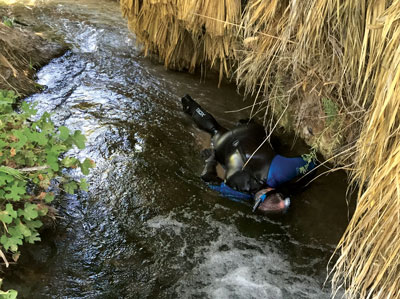By VERNON ROBISON
Moapa Valley Progress

Biologists were disappointed earlier this month to find a significant reduction in the number of endangered Moapa dace counted in the headwaters of the Muddy River during a routine semi-annual survey of the Warm Springs area.
This year the dace count, which occurred on August 9-10, recorded only 1,635 Moapa dace in the stream. Down 547 fish since last August, this represents a decrease of about 25% over the past year.
But biologists say that they aren’t too worried at this point. Those who have spent the past decade watching and counting the small, finger-sized fish that lives only in the warm artesian source of the Muddy River have become accustomed to seeing significant fluctuations in its population.
In recent years, that fluctuation has been tremendously positive. The dace population went from 713 fish observed in August 2011 to 2,248 in August 2013. That was the highest number of dace observed since the count began back in 2005.
But since 2013 the dace numbers have evened out and fallen slightly. Last year’s 2015 count yielded 2,182 dace, about 3 percent off of the previous year’s high.
But even these decreases are minimal compared to the major crash that occurred in 2008. That year more than half of the population of dace inexplicably disappeared from the stream.
Despite the off year, experts remain optimistic about the dace. They say that habitat conditions are still optimal for the little fish. So all signs point to an expected resurgence in numbers, they say.
During the count, about a dozen experts from U.S. Fish and Wildlife, Nevada Department of Wildlife and Southern Nevada Water Authority (SNWA) fanned out throughout the area to take the survey. They divided into teams of two where one person snorkels the small stream counting fish and the other walks along the banks to record the numbers called out.
During that time, the scientists also get to observe the habitat conditions.
“The habitat looked good,” said SNWA biologist David Syzdek last week in an interview. “The dace like turbulent water and we are seeing plenty of pockets of that.”
In addition, the observers saw all of the different size classes of fish from larvae to juveniles to adults. That means that the fish are reproducing, Syzdek said.
Finally, there were no signs of invasive species in the stream. This was due to efforts over the past two years to eradicate non-native fish, like the blue tilapia, from the dace habitat using chemicals.
Some time ago, a fish barrier was placed in the stream below the far western reaches of the river where dace habitat restoration was being focused. This prevented non-native predators from swimming up into that area of the stream. A chemical was then released into the other reaches of the river to eradicate the predators.
Last year, after experts were certain that all the invasive species had been eradicated from the area, the fish barrier was opened and the dace were able to roam freely into other reaches of the stream that were once their traditional habitat.
This brought one of the bright spots of this year’s dace count, according to Syzdek.
“Fortunately, we saw a few fish move around into areas where we haven’t seen much of them before,” Syzdek said.
In an area called Reach 14, which is roughly in the vicinity of the LDS Ranch property, NDOW experts observed 11 dace. This was an area where there have traditionally not been any dace noted.
Unfortunatly, there were no other dace observed in the reaches surrounding Reach 14.
“I am confident that with all of this extra habitat now, the dace numbers are going to shoot up,” Syzdek said. “I was really hoping that we would see that happen this year, but it didn’t. It might just take a while for them to figure out the new system.”
“In any case, I think that having the entire historical habitat now open to them is going to be really good in the long term,” he concluded. “So we are not worried.”










